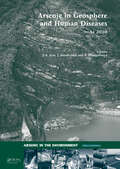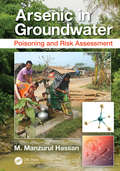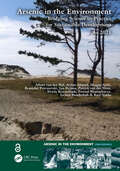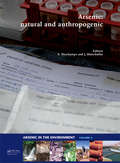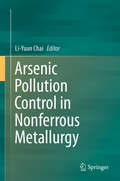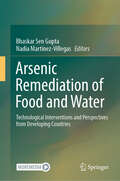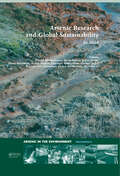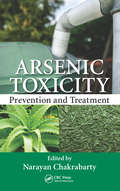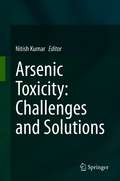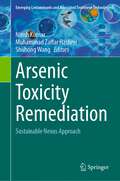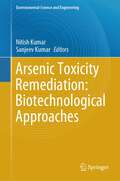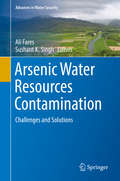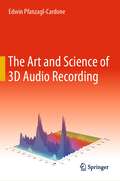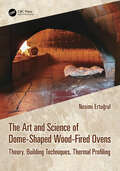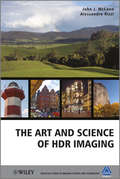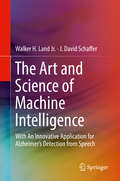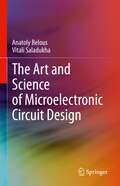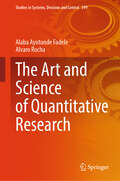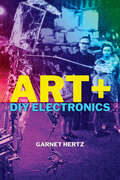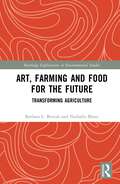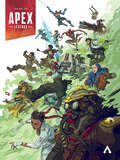- Table View
- List View
Arsenic in Geosphere and Human Diseases; Arsenic 2010: Proceedings of the Third International Congress on Arsenic in the Environment (As-2010) (Arsenic in the Environment - Proceedings)
by Jiin-Shuh Jean Jochen Bundschuh Prosun BhattacharyaThe congress "Arsenic in the Environment" offers an international, multi- and interdisciplinary discussion platform for arsenic research aimed at short-term solutions of problems with considerable social impact, rather than only focusing on cutting edge and breakthrough research in physical, chemical, toxicological, medical and other specific issue
Arsenic in Groundwater: Poisoning and Risk Assessment
by M. Manzurul HassanArsenic-contaminated groundwater is considered one of the world’s largest environmental health crises, as more than 300 million people in more than one-third of countries worldwide are at risk of groundwater arsenic poisoning. This book addresses how arsenic in groundwater impacts human health by using the frameworks of natural sciences, social sciences, and health sciences in the context set by environmental and legal considerations. Arsenic in Groundwater: Poisoning and Risk Assessment examines the spatial, quantitative, and qualitative aspects on arsenic poisoning; for instance, using geographical information systems (GIS) to investigate the spatial discontinuity of arsenic-laced water in spatial and temporal dimensions to uncover patterns of variations over scales from meters to kilometers. Spatial risk mapping provides insight for academics, researchers, policy makers, and politicians on possible long-term strategies for arsenic mitigation. Qualitative methodological approaches uncover the hidden issues of arsenic poisoning on human health and the related social implications. The book also examines legal aspects, such as the right to safe drinking water, as well as an in-depth look at how community participation can shape public policy. Features: Describes arsenic poisoning from both the scientific and social science perspectives Includes technical insights drawn from GIS-based modeling for spatial arsenic discontinuity and spatial health risks of arsenic poisoning Provides a state-of-the-art review of the human health literature and cutting-edge scientific evidence for arsenic-related health and social implications Examines the environmental justice and legal issues of drinking water and its quality Presents environmental policy and public mitigation strategies with Public Participation GIS (PPGIS) related to arsenic contamination More than 2,000 references serve as valuable resources for various aspects of arsenic poisoning
Arsenic in the Environment: Proceedings of the 8th International Congress and Exhibition on Arsenic in the Environment (As2021), June 7-9, 2021, Wageningen, The Netherlands (Arsenic in the Environment - Proceedings)
by van der Wal, Albert Arslan Ahmad Branislav Petrusevski Jan Weijma Dragan Savic van der Wens, Patrick Erwin Beerendonk Prosun Bhattacharya Jochen Bundschuh Ravi NaiduThe Congress and Exhibition Series "Arsenic in the Environment" offers an international, multi- and interdisciplinary discussion platform for research and innovation aimed towards a holistic solution to the challenges posed by the environmental toxin arsenic, with global societal impact. The Congress has focused on cutting edge and breakthrough research in physical, chemical, toxicological, medical, agricultural and other specific issues on arsenic across a broader environmental realm. The Biennial Congress and Exhibition "Arsenic in the Environment" was first organized in Mexico City (As2006) followed by As2008 in Valencia (Spain), As2010 in Tainan (Chinese Taiwan), As2012 in Cairns (Australia), As2014 in Buenos Aires (Argentina), As2016 in Stockholm (Sweden) and As2018 in Beijing (P.R. China).The 8th International Congress As2020 was held June 7-9, 2021 (first time digitally owing to the global COVID-19 pandemic, in Wageningen, The Netherlands) and with a title Arsenic in the Environment - Bridging Science to Practice for Sustainable Development. The Congress addressed the broader context of arsenic research aligned on the following themes:Theme 1: Arsenic in Natural Soil and Water SystemsTheme 2: Arsenic in Agriculture and Food ProductionTheme 3: Health Impacts of ArsenicTheme 4: Technologies for Arsenic Removal from WaterTheme 5: Sustainable Mitigation and Management for Sustainable DevelopmentArsenic in drinking water and food is a major health issue, affecting millions of people in many parts of the world. In recent years serious cases of arsenic exposure through different environmental matrices have been reported from, for example, Argentina, Bangladesh, Chile, China, Taiwan, Turkey, India, Mexico, UK, USA, Pakistan, Vietnam as well as other regions in the world. Arsenic can cause a number of carcinogenic and non-carcinogenic adverse effects on human health and therefore human exposure to arsenic should be avoided. Notably, The Netherlands has been in the forefront of research on arsenic removal technology and developed a cutting edge innovation to remove arsenic to levels below the WHO drinking water guideline to as low as less than 1 μg/L. This has created an enabling environment to discuss on policy issues for defining the new drinking water guideline. The Congress has attracted professionals involved in different segments of interdisciplinary research on arsenic in an open forum, and strengthened relations between academia, research institutions, government and non-governmental agencies, industries, and civil society organizations to share an optimal ambience for exchange of knowledge.
Arsenic: Natural and Anthropogenic (Arsenic in the environment)
by Eleonora Deschamps Jörg MatschullatThe discussion on arsenic in the environment is complex and must grasp the importance of very many, mostly unrelated works on individual aspects. This volume represents one of the first comprehensive and interdisciplinary examinations into arsenic's behaviour in air, water, soils, sediments, plants and the human body. Based on state-of-the-art investigations into the global arsenic cycle, the related human toxicology and available remediation technologies, arsenic is assessed holistically in all the environmental compartments. Using the results of primary research, the authors offer concrete suggestions for risk reduction and management of environmental pollution that allow the reader to successfully tackle similar problems and find sustainable solutions.
Arsenic Pollution Control in Nonferrous Metallurgy
by Li-Yuan ChaiThe control of arsenic pollution has attracted worldwide attention, as it is one of the top 20 hazardous substances, and greatly threatens the human health, ecological balance, and industrial development. Arsenic pollution results from natural enrichment and anthropological activities, especially mining and smelting operations. This book introduces arsenic pollution control technologies for aqueous solution and solid wastes produced by the utilization of arsenic-containing materials. It systematically discusses the principles and technologies of arsenic pollution control based on the author’s 16 years of research on arsenic, to help readers gain an understanding of various aspects of arsenic pollution control, including the pollution source distribution of arsenic in typical smelters, arsenic behaviors and pollution control technologies in aqueous solution and solid waste, and clean unitization of arsenic-containing materials.
Arsenic Remediation of Food and Water: Technological Interventions and Perspectives from Developing Countries
by Bhaskar Sen Gupta Nadia Martínez-VillegasThe book provides information on the sources of arsenic contamination of groundwater and their impacts in the first part of the book consisting of 8 chapters. Process developments such as nano-adsorbents for removal of arsenic and other heavy metals are discussed in the second part of the book that comprises of 4 chapters. The third part of the book includes 4 chapters on technological interventions for the removal of arsenic such as indigenous ceramic membranes and Subterranean Arsenic Removal (SAR). The fourth part of the book deals with arsenic contamination in food materials and food chain systems, and consists of 5 chapters. Arsenic has long been associated with a variety of health complications in the human body. In order to address this, a chapter on arsenic contamination and impacts on human health has been included in the fifth part of the book. The book would be a valuable reference material for the scientific community in developing countries working on community water supply and treatment, food safety, public health and policy.
Arsenic Research and Global Sustainability: Proceedings of the Sixth International Congress on Arsenic in the Environment (As2016), June 19-23, 2016, Stockholm, Sweden (Arsenic in the Environment - Proceedings)
by Prosun Bhattacharya Marie Vahter Jerker Jarsjö Jurate Kumpiene Arslan Ahmad Charlotte Sparrenbom Gunnar Jacks Marinus Eric Donselaar Jochen Bundschuh Ravi NaiduThe Congress "Arsenic in the Environment" offers an international, multi- and interdisciplinary discussion platform for research and innovation aimed towards a holistic solution to the problem posed by the environmental toxin arsenic, with considerable societal impact. The congress has focused on cutting edge and breakthrough research in physical, chemical, toxicological, medical, agricultural and other specific issues on arsenic across a broader environmental realm. The Congress "Arsenic in the Environment" was first organized in Mexico City (As2006) followed by As2008 in Valencia, Spain, As2010 in Tainan, Taiwan, As2012 in Cairns, Australia and As2014 in Buenos Aires, Argentina. The 6th International Congress As2016 was held June 19-23, 2016 in Stockholm, Sweden and was entitled Arsenic Research and Global Sustainability. The Congress addressed the broader context of arsenic research along the following themes:Theme 1: Arsenic in Environmental Matrices and Interactions (Air, Water, Soil and Biological Matrices)Theme 2: Arsenic in Food ChainTheme 3: Arsenic and HealthTheme 4: Clean Water Technology for Control of ArsenicTheme 5: Societal issues, Policy Studies, Mitigation and ManagementLong term exposure to low-to-medium levels of arsenic via contaminated food and drinking water can have a serious impact on human health and globally, more than 100 million people are at risk. Since the end of the 20th century, arsenic in drinking water (mainly groundwater) has emerged as a global health concern. In the past decade, the presence of arsenic in plant foods – especially rice – has gained increasing attention. In the Nordic countries in particular, the use of water-soluble inorganic arsenic chemicals (e.g. chromated copper arsenate, CCA) as wood preservatives and the mining of sulfidic ores have been flagged as health concern. The issue has been accentuated by discoveries of naturally occurring arsenic in groundwater, primarily in the private wells, in parts of the Fennoscandian Shield and in sedimentary formations, with potentially detrimental effects on public health. Sweden has been at the forefront of research on the health effects of arsenic, technological solutions for arsenic removal, and sustainable mitigation measures for developing countries. Hosting this Congress in Sweden was also relevant because historically Sweden has been one of the leading producer of As2O3 and its emission from the smelting industries in northern Sweden and has successfully implemented actions to reduce the industrial emissions of arsenic as well as minimizing the use of materials and products containing arsenic in since 1977. The Congress has gathered professionals involved in different segments of interdisciplinary research in an open forum, and strengthened relations between academia, industry, research laboratories, government agencies and the private sector to share an optimal atmosphere for exchange of knowledge, discoveries and discussions about the problem of arsenic in the environment and catalyze the knowledge generation and innovations at a policy context to achieve the goals for post 2015 Sustainable Development.
Arsenic & Rice
by Andrew A. Meharg Fang-Jie ZhaoRice is the staple food for half of the world's population. Consumption of rice is the major exposure route globally to the class one, non-threshold carcinogen inorganic arsenic. This book explains the sources of arsenic to paddy soils and the biogeochemical processes and plant physiological attributes of paddy soil-rice ecosystems that lead to high concentrations of arsenic in rice grain. It presents the global pattern of arsenic concentration and speciation in rice, discusses human exposures to inorganic arsenic from rice and the resulting health risks. It also highlights particular populations that have the highest rice consumptions, which include Southern and South East Asians, weaning babies, gluten intolerance sufferers and those consuming rice milk. The book also presents the information of arsenic concentration and speciation in other major crops and outlines approaches for lowering arsenic in rice grain and in the human diet through agronomic management.
Arsenic Toxicity: Prevention and Treatment
by Narayan ChakrabartyThe most talked about metalloid in the modern world, arsenic affects the liver, kidney, and lungs; leads to cardiovascular diseases, cancer, and diabetes; and may cause blindness with long-time exposure. With naturally occurring arsenic boosted by mining and other industrial processes contaminating soil and drinking water, arsenic toxicity is a maj
Arsenic Toxicity: Challenges and Solutions
by Nitish KumarArsenic (As) is a widely distributed element in the environment having no known useful physiological function in plants or animals. Historically, this metalloid has been known to be used widely as a poison. Effects of arsenic have come to light in the past few decades due to its increasing contamination in several parts of world, with the worst situation being in Bangladesh and West Bengal in India. This edited volume brings together diverse group of environmental science, sustainability and health researchers to address the challenges posed by global mass poisoning caused by arsenic water contamination. The book covers sources of arsenic contamination, and its impact on human health and on prospective remediation both by bioremediation and phytoremediation. Applications of advance techniques such as genetic engineering and nanotechnology are also discussed to resolve the issue of arsenic contamination in ground water and river basins. The book sheds light on this global environmental issue, and proposes solutions to remove contamination through a multi-disciplinary lens and case studies from Bangladesh and India. The book may serve as a reference to environment and sustainability researchers, students and policy makers. It delivers an outline to graduate, undergraduate students and researchers, as well as academicians who are working on arsenic toxicity with respect to remediation and health issues.
Arsenic Toxicity Remediation: Sustainable Nexus Approach (Emerging Contaminants and Associated Treatment Technologies)
by Nitish Kumar Muhammad Zaffar Hashmi Shuhong WangArsenic contamination in drinking water and crops is a major health issue in many countries worldwide, threatening the health of millions of people due to arsenic’s toxicity and carcinogenicity. This edited volume brings together a diverse group of environmental science, sustainability and health researchers to address the challenges posed by arsenic contamination. The book sheds light on this global environmental issue and proposes solutions to aquatic contamination through multi-disciplinary sustainable approaches and case studies from different parts of the world. The chapters contained here present the status quo in different parts of the world and provide essential information on arsenic exposure risks for humans as well as possible measures for tackling arsenic poisoning. The mechanisms of arsenic uptake, translocation and distribution in plants and grains are also explained. In closing, the book reviews a variety of prospective sustainable solutions to the problem of arsenic accumulation in soil and water. The book is comprised of three sections. The first section describes the routes of exposure to environmental arsenic and its transport in soil and aquatic ecosystems. The second section explains the health risks linked to arsenic exposure in food and the environment. The third section addresses sustainable arsenic contamination mitigation strategies using the potential applications of recent biological technology such as biotechnology, bioremediation, phytoremediation, biochar, absorbent, genetic engineering, and nanotechnology approaches. The book is intended for a broad audience including researchers, scientists, and readers with diverse backgrounds.
Arsenic Toxicity Remediation: Biotechnological Approaches (Environmental Science and Engineering)
by Nitish Kumar Sanjeev KumarArsenic contamination in drinking water and associated adverse outcomes is one of the major health issues in more than 50 countries worldwide. The scenario is getting even more detrimental with increasing number of affected people and newer sites reported from all over the world. Apart from drinking water, the presence of arsenic has been found in various other dietary sources. Threatening the health of millions of people due to arsenic’s toxicity and carcinogenicity, the major routes of arsenic exposure for humans are either through drinking water or crops. This edited volume brings together a diverse group of environmental science, sustainability, and health researchers to address the challenges posed by global mass poisoning caused by arsenic water contamination. The book sheds light on this global environmental issue and proposes solutions to aquatic contamination through multi-disciplinary sustainable approaches and case studies from different parts of world. This book addresses the problem of arsenic by pursuing a holistic approach. It presents the status quo in different parts of the world and provides essential information on food-related arsenic exposure risks for humans and possible preventive and curative measures for tackling arsenic poisoning. The mechanisms of arsenic uptake, translocation, and distribution in plants and grains are also explained. In closing, the book reviews a variety of prospective sustainable solutions to the problem of arsenic accumulation in soil and water.The book comprises three sections. First section describes the routes of exposure to environmental arsenic and its transport in soil and aquatic ecosystems including its source and distribution in specific locations. Second section explains the health risks linked to arsenic exposure in food and the environment. Third section addresses sustainable arsenic contamination mitigation strategies using the potential applications of recent biotechnological techniques, bioremediation, phytoremediation, genetic engineering, nanotechnology, and in silico approaches.The book is intended for a broad audience including researchers, scientists, and readers with diverse backgrounds including agriculture, environmental science, food science, environmental management, and human health. It can also be used as an important reference guide for undergraduate and graduate students, university faculties, and environmentalists. The book may serve as a reference to environment and sustainability researchers, students, and policy makers.
Arsenic Water Resources Contamination: Challenges and Solutions (Advances in Water Security)
by Ali Fares Sushant K. SinghThis edited volume brings together a diverse group of environmental science, sustainability and health researchers to address the challenges posed by global mass poisoning caused by arsenic water contamination. The book sheds light on this global environmental issue, and proposes solutions to aquatic contamination through a multi-disciplinary lens and case studies from Bangladesh and India. The book may serve as a reference to environment and sustainability researchers, students and policy makers.Part one of the book describes the issue of arsenic contamination in ground water and river basins, including its source and distribution in specific locations in India. Part two explains the routes of exposure to environmental arsenic, its transport in aquatic ecosystems, and the health risks linked to arsenic exposure in food and the environment. Part three addresses sustainable arsenic contamination mitigation strategies and policies, the socioeconomic, demographic, cultural and psychological aspects of arsenic contamination, and the potential applications of GIS and remote sensing in providing solutions. Part four concludes by discussing the role of local and regional institutions in water resources management for a variety of issues including but not limited to arsenic contamination, and presents a case study in the Indus river basin in Pakistan to propose future contamination mitigation strategies.
The Art and Science of 3D Audio Recording
by Edwin Pfanzagl-CardoneThis professional book offers a unique, comprehensive and timely guide on 3D audio recording. Intended for sound engineers and professionals, and summarizing more than twenty-year research on this topic, it includes extensive information and details on various microphone techniques and loudspeaker layouts, such as Auro-3D®, Dolby® AtmosTM, DTS:X®, MMAD, SONY 360 Reality Audio and Ambisonics. It presents a rich set of results obtained from both objective measurements and subjective listening tests, and a number of case studies for 3D recording, ranging from solo-instrument techniques to full symphony orchestra, and microphone systems for virtual reality applications. Further, it includes a chapter on spatial hearing discussing issues of 3D audio sound reproduction. All in all, this book offers extensive, practical information for sound engineers and professionals.
The Art and Science of Dome-Shaped Wood-Fired Ovens: Theory, Building Techniques, Thermal Profiling
by Nesimi ErtuğrulThe Art and Science of Dome-Shaped Wood-Fired Ovens, from history to your backyard or commercial shop, is a carefully crafted guide that explains the tradition and science of wood-fired cooking. The book embarks on a historical journey, tracing the development of wood-fired ovens and their cultural significance. It then unravels the theory of heating and the burning behaviour of wood, making complex technical concepts accessible.Transitioning from theory to practice, the guide outlines the design and construction process of a wood-fired oven. It considers engineering aspects and locally available materials, emphasizing efficient, sustainable building. The book discusses essential cooking utensils and tools, shedding light on the entire cooking process, from fire-starting to ash disposal.In a unique chapter on data logging, readers are introduced to modern temperature monitoring techniques. It shows how managing thermal mass can expand the range of recipes beyond the commonly perceived breads and pizzas. Lastly, the book explores Turkish cuisine, debunking preconceptions and presenting a wide array of dishes suitable for wood-fired ovens. The recipes span from traditional Turkish to International cuisines and fusion recipes, equipping readers with the tools to broaden their culinary repertoire.This book serves as an indispensable resource for anyone interested in wood-fired cooking, blending historical context, technical insights, practical advice, and mouth-watering recipes into a compelling narrative. This comprehensive manual aims to bring wood-fired cooking into the heart of modern culinary practice.
The Art and Science of HDR Imaging
by Alessandro Rizzi John J. MccannRendering High Dynamic Range (HDR) scenes on media with limited dynamic range began in the Renaissance whereby painters, then photographers, learned to use low-range spatial techniques to synthesize appearances, rather than to reproduce accurately the light from scenes. The Art and Science of HDR Imaging presents a unique scientific HDR approach derived from artists' understanding of painting, emphasizing spatial information in electronic imaging.Human visual appearance and reproduction rendition of the HDR world requires spatial-image processing to overcome the veiling glare limits of optical imaging, in eyes and in cameras. Illustrated in full colour throughout, including examples of fine-art paintings, HDR photography, and multiple exposure scenes; this book uses techniques to study the HDR properties of entire scenes, and measures the range of light of scenes and the range that cameras capture. It describes how electronic image processing has been used to render HDR scenes since 1967, and examines the great variety of HDR algorithms used today. Showing how spatial processes can mimic vision, and render scenes as artists do, the book also:Gives the history of HDR from artists' spatial techniques to scientific image processingMeasures and describes the limits of HDR scenes, HDR camera images, and the range of HDR appearancesOffers a unique review of the entire family of Retinex image processing algorithmsDescribes the considerable overlap of HDR and Color Constancy: two sides of the same coinExplains the advantages of algorithms that replicate human vision in the processing of HDR scenesProvides extensive data to test algorithms and models of vision on an accompanying websitewww.wiley.com/go/mccannhdr
The Art and Science of Machine Intelligence: With An Innovative Application for Alzheimer’s Detection from Speech
by J. David Schaffer Walker H. Land Jr.This volume presents several machine intelligence technologies, developed over recent decades, and illustrates how they can be combined in application. One application, the detection of dementia from patterns in speech, is used throughout to illustrate these combinations. This application is a classic stationary pattern detection task, so readers may easily see how these combinations can be applied to other similar tasks. The expositions of the methods are supported by the basic theory they rest upon, and their application is clearly illustrated. The book’s goal is to allow readers to select one or more of these methods to quickly apply to their own tasks.Includes a variety of machine intelligent technologies and illustrates how they can work togetherShows evolutionary feature subset selection combined with support vector machines and multiple classifiers combinedIncludes a running case study on intelligent processing relating to Alzheimer’s / dementia detection, in addition to several applications of the machine hybrid algorithms
The Art and Science of Microelectronic Circuit Design
by Anatoly Belous Vitali SaladukhaThis book guides readers through the entire complex of interrelated theoretical and practical aspects of the end-to-end design and organization of production of silicon submicron integrated circuits. The discussion includes the theoretical foundations of the operation of field-effect- and bipolar transistors, the methods and peculiarities of the structural and schematic design, basic circuit-design and system-design engineering solutions for bipolar, CMOS, BiCMOS and TTL integrated circuits, standard design libraries, and typical design flows.
The Art and Science of NFC Programming
by Anne-Marie Lesas Serge MirandaNFC is a world standard since 2004 which is now within every smartphone on the market. Such a standard enables us to do mobile transactions (mobile payment) in a secure way along with many other information- based tap’n play operations. This book has a double role for computer scientists (from bachelor students in CS to IT professionals).
The Art and Science of Quantitative Research (Studies in Systems, Decision and Control #599)
by Alvaro Rocha Alaba Ayotunde FadeleThis book reflects on the insights gained from exploring the key dimensions of quantitative research as outlined in the preceding chapters. Quantitative research, with its emphasis on objectivity, systematic methodologies, and statistical rigor, plays a pivotal role in advancing knowledge across diverse fields. The study began with an introduction to its foundational principles, highlighting its distinct characteristics and relevance. Key conclusions drawn from each chapter are summarized below:In the first chapter, a basic knowledge of quantitative research was presented, with an emphasis on the methodical and organized approach that quantitative research takes to the study of observable events. Quantitative research differs from qualitative research in that it focuses on numerical data, statistical analysis, and objective findings, as opposed to qualitative research, which investigates subjective experiences and meanings. This contrast highlights the crucial role that quantitative approaches play in hypothesis testing and predictive analysis, which makes them very beneficial for academic subjects that need empirical data and findings that can be replicated from experiment to experiment. In the next chapter, we delved further into the fundamental aspects of quantitative research, including its dependence on organized instruments (such as surveys and experiments), the significance of operationalizing variables, and the pursuit of results that can be generalized. When it comes to answering problems that need accuracy, scalability, and statistical validity, quantitative research is an indispensable tool because of these inherent characteristics. At the same time, the chapter brought attention to the attitude of the researcher, which includes taking an objective perspective, reducing prejudice, and adhering to ethical norms. This frame of mind is very necessary in order to guarantee the honesty and dependability of the findings of the investigation.
The Art and Science of Rotating Field Machines Design: A Practical Approach
by Vlado OstovićThis book highlights procedures utilized by the design departments of leading global manufacturers, offering readers essential insights into the electromagnetic and thermal design of rotating field (induction and synchronous) electric machines. Further, it details the physics of the key phenomena involved in the machines' operation, conducts a thorough analysis and synthesis of polyphase windings, and presents the tools and methods used in the evaluation of winding performance. The book develops and solves the machines' magnetic circuits, and determines their electromagnetic forces and torques. Special attention is paid to thermal problems in electrical machines, along with fluid flow computations. With a clear emphasis on the practical aspects of electric machine design and synthesis, the author applies his nearly 40 years of professional experience with electric machine manufacturers - both as an employee and consultant - to provide readers with the tools they need to determine fluid flow parameters and compute temperature distributions.
The Art and Science of Surround and Stereo Recording: Including 3D Audio Techniques
by Edwin Pfanzagl-CardoneThis book presents an extensive and timely survey of more than 30 surround and 20 stereo-microphone techniques. Further, it offers, for the first time, an explanation of why the RCA "Living Stereo" series of legacy recordings from the 1950s and 60s is still appreciated by music lovers worldwide, despite their use of an apparently incorrect recording technique from the perspective of psychoacoustics. Discussing this aspect in detail, the book draws on the author’s study of concert hall acoustics and psychoacoustics. The book also analyzes the "fingerprint" features of a selected number of surround and – more importantly – stereo microphone techniques in depth by measuring their signal cross-correlation over frequency and also using an artificial human head. In addition, the book presents a rating of microphone techniques based on the assessment of various acoustic attributes, and merges the results of several subjective listening tests, including those conducted by other researchers. Building on this knowledge, it provides fresh insights into important microphone system features, from stereo to 3D audio. Moreover, it describes new microphone techniques, such as AB-PC, ORTF-T and BPT, and the recently defined BQIrep (Binaural Quality Index of reproduced music). Lastly, the book concludes with a short history of microphone techniques and case studies of live and studio recordings.
Art + DIY Electronics
by Garnet HertzA systematic theory of DIY electronic culture, drawn from a century of artists who have independently built creative technologies.Since the rise of Arduino and 3D printing in the mid-2000s, do-it-yourself approaches to the creative exploration of technology have surged in popularity. But the maker movement is not new: it is a historically significant practice in contemporary art and design. This book documents, tracks, and identifies a hundred years of innovative DIY technology practices, illustrating how the maker movement is a continuation of a long-standing creative electronic subculture. Through this comprehensive exploration, Garnet Hertz develops a theory and language of creative DIY electronics, drawing from diverse examples of contemporary art, including work from renowned electronic artists such as Nam June Paik and such art collectives as Survival Research Laboratories and the Barbie Liberation Front. Hertz uncovers the defining elements of electronic DIY culture, which often works with limited resources to bring new life to obsolete objects while engaging in a critical dialogue with consumer capitalism. Whether hacking blackboxed technologies or deploying culture jamming techniques to critique commercial labor practices or gender norms, the artists have found creative ways to make personal and political statements through creative technologies. The wide range of innovative works and practices profiled in Art + DIY Electronics form a general framework for DIY culture and help inspire readers to get creative with their own adaptations, fabrications, and reimaginations of everyday technologies.
Art, Farming and Food for the Future: Transforming Agriculture (Routledge Explorations in Environmental Studies)
by Barbara L. Benish Nathalie BlancThis book explores the impact of artistic experiments in inspiring people to turn away from current food consumerism and take an active role in preserving, sustaining, and protecting the environment. As artists are expanding their practice into social justice and community concerns, erasing traditional forms of expression and integrating others, the culture around food and its production has been added to a new vocabulary of experiential art. The authors measure the impact of such experiments on local food consumption and production, focusing on education and youth, both in the surrounding community and culture at large. They suggest how these projects can be up-scaled to further encourage sustainable solutions for our environment and communities. The book explores the reflections and motivations of case study practitioners in urban and rural areas and, through interviews, engages with artists who are pioneering a new trend to create hubs of activity away from traditional art spaces in cities to follow a non-hierarchal practice that is de-centralized and communally based. This book will be of great interest to academic readers concerned with issues related to environmental aesthetics, eco-design, eco-criticism, culture, heritage, memory, and identity, and those interested in the current debates on the place of aesthetics and culture in sustainability.
The Art of Apex Legends
by Respawn EntertainmentAn oversized hardcover volume cataloging art and developer commentary on Apex Legends, the hit competitive first-person shooter.The next evolution of battle royale has arrived, and it can now be enjoyed in more detail than ever before. Pore over the finest features of unique legendary skins, marvel at the deadly intricacies of every dynamic weapon, explore each nook and cranny of the game's battle-scarred arenas, and more!Whether you main Wraith or Mirage, are a hardcore aggressor or a fastidious shotcaller, or even if you're just a fan of gorgeous video game concept art and intimate creator commentary, The Art of Apex Legends is sure to thrill fans of any stripe!
